The U.S. military has not seen any drone swarms near its bases since mysterious incidents befell a key Virginia military base last year. But there are still roughly two to three cases a week of drones flying into the airspace around U.S. military bases in America, a senior defense official said May 8.
“You can only report what you see, and so that’s part of the challenge,” the senior defense official told a small group of reporters at the Pentagon when asked about the drone incidents. “But I’d say that’s usually two or three a week, total across the U.S. And it’s never primarily in one part of the country or another. It’s fairly random, or it seems to be random.”
Joint Base Langley-Eustis experienced a number of drone incursions last December—bringing home an issue the U.S. has had to face abroad in the Middle East. It is unclear who was behind the drone swarms. U.S. officials have cautioned the issue is far different than the drone threat in the Middle East or Ukraine, where Iranian one-way attack drones have been used to deadly effect by Iran’s proxies and Russia.
“We haven’t seen anything that indicates they’re nefarious,” the defense official said of the drone incidents in the U.S. The official said they suspected “most of it is hobbyists.”
Nevertheless, the possibility that someone with ill intent could launch an attack or surveillance drone at a U.S. base lingers. The U.S. already has to deal with incursions at its bases on land—though those are mostly by individuals such as lost tourists and end without further incident. But some of those cases have raised alarm. So drone incursions around military bases are cause for concern.
U.S. officials are “paid to be worried about the worst case,” said the senior defense official. “I treat them all as if it’s nefarious until we hear otherwise.”
The U.S. is tracking some small drones around the southern border as well, usually by groups suspected of scoping out the locations of law enforcement personnel, the official said. A few drones are suspected of carrying illegal drugs on behalf of cartels.
“There are very small numbers of ones that carry a small drug payload that have been captured,” the official said. “We haven’t seen any that are weaponized that have come across the border.”
“We really want to see what we can do, interagency, together to see what we can do to limit those incursions,” the official added.
NORAD and U.S. Northern Command’s new commander, Air Force Gen. Gregory M. Guillot, has said he was surprised upon taking command of NORTHCOM by how much focus he needed to put on countering drones, especially compared to his previous jobs as head of Air Forces Central (AFCENT) and deputy commander of U.S. Central Command, where drone threats are pervasive.
“Of course, I knew it was an issue coming from another combatant command where we faced that threat in a very different way because of the environment,” Gulliot told Congress in March. “But I wasn’t prepared for the number of incursions that I see.”
The threat is new for the U.S. homeland, which poses unique challenges. In Iraq, Syria, Jordan, and other locations in the Middle East, the U.S. military usually does not need to deconflict with civilian aviation. The successful takedown of more than 300 ballistic missiles, cruise missiles, and drones by Israel, U.S. F-15Es and F-16s, and coalition partners was made possible because some nations closed their airspace, and the U.S. coordinated the movement of coalition aircraft and air defense at the Combined Air Operations Center at Al Udeid Air Base in Qatar. But in the U.S., the skies are filled with commercial and general aviation planes, so the military must coordinate with the Federal Aviation Administration (FAA).
“It’s not like in the Middle East,” the official said of the unique challenges posed by drones in the U.S.
But the senior defense official said they were confident the U.S. government understands small drones pose a threat worldwide.
“There is a very genuine desire in this building to not only address it from the military standpoint but also cooperate across the interagency,” the official said. “They [could] go after critical infrastructure, not just bases, but it could be any number of locations. And sharing information, I think, is the key first step in being able to address it, getting some sort of common operational picture, like we do with radars for aircraft. But it just doesn’t exist at this point for UAVs.”
